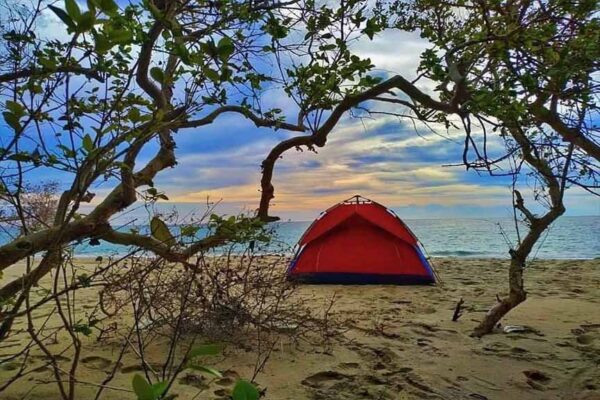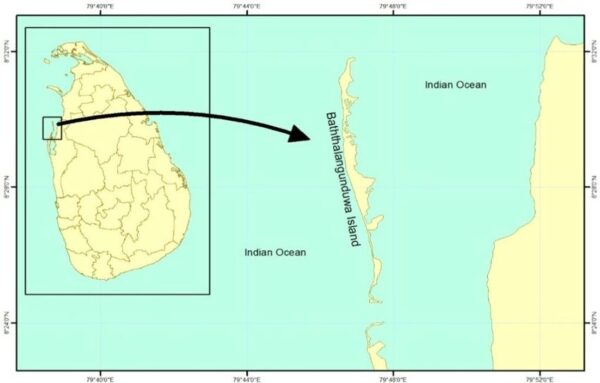Baththalangunduwa Island – ideal destination for beach camping – By Arundathie Abeysinghe

 A tiny island of approximately five square kilometers in size, located approximately 38 kilometers (20 nautical miles) away from *Kalpitiya in the Puttalam District of the North Western Province of Sri Lanka, Baththalangunduwa is popular as a beach camping site. It is an island located in the Dutch Bay (also known as Portugal Bay). Baththalangunduwa is one of the few inhabited islands to the north of Puttalam Lagoon.
A tiny island of approximately five square kilometers in size, located approximately 38 kilometers (20 nautical miles) away from *Kalpitiya in the Puttalam District of the North Western Province of Sri Lanka, Baththalangunduwa is popular as a beach camping site. It is an island located in the Dutch Bay (also known as Portugal Bay). Baththalangunduwa is one of the few inhabited islands to the north of Puttalam Lagoon.
Battalangunduwa is a fishing village with a population of approximately 3000 inhabitants. The majority of them are Catholics, mostly from *Chilaw and *Negombo with a substantial population of Tamil Catholics from Jaffna. Hence, the culture in Battalangunduwa is a stimulating mix and the language is a mixture of Tamil and Sinhalese, similar to residents of Negombo. The one and only livelihood within the Island is fishing. The Island borders the vast Indian Ocean from one side and the large Portugal Bay from the opposite side.
Despite being a fishing village, the Island has also become a popular destination for travelers looking for adventure off the beaten track.
The majority of tourists visiting Kalpitiya, visit Baththalangunduwa and the journey to Baththalangunduwa begins at Kalpitiya. There is a ferry service that takes passengers to the island daily, except on Sundays. The journey to Baththalangunduwa takes three hours. The boats operate Monday to Saturday by 8.30 a.m. Parking is available inside the park of the fishery harbor. Residents of Baththalangunduwa are renowned for their hospitality.
The journey by ferry to the Island is a different experience. Towards the right, the ferry passes long stretches of *Wilpattu National Park till it heads off to the island. Spotting birds looking for prey, dotted with thatched fishing huts and fishermen heading off to the sea is a common sight. At times, a dolphin or two can also be seen.
Along the journey from Kalpitiya, numerous uninhabited islands can be seen. During the journey, it is necessary to protect electronic equipment from sea spray. Hence, it is advisable to move to the middle of the ferry and shield from the sea’s onslaught. At the end of the three-hour journey, a helper in the boat issues tickets to each passenger.
The Island is bare, apart from a small area with some coconut groves and mangrove shrubs and it is a perfect location for fishing and dried fish industry.
Some fishermen in Baththalangunduwa work in the ‘ice wadiya’ packing sword fish in ice to be exported, others either lay down in their boats for a short slumber or patch their fishing nets. Although, life in Baththalangunduwa appears laid back and hard, people seem content.
As the boat moors and passengers scramble off the ferry at the end of ferry ride, they are greeted with friendly smiles, many eager to direct the visitors to the Island to their destinations. As visitors travel to different locations, many residents who arrived in the ferry head off to the Church along with their families “to pray and thank God for their safe return”. The lives of the people in Baththalangunduwa revolve around fishing and religion.
The Island is dotted with thatched fishing huts and a large number of Christian shrines dedicated to diverse saints. Although, Baththalangunduwa is a tiny island, there are three churches and according to the fishermen, the feasts of these churches are held on a grand scale, annually.
To the majority, the Island is their workplace and they travel to and from their villages when the catch is good. According to fishermen, there are no permanent residents in Baththalangunduwa. There are some school children brought to the Island by their parents during the season. The Sri Lanka Navy operates a school, so they can pursue their education. Some residents lament that eventually, Baththalangunduwa will disappear due to rising seas, a fate that has befallen several islands in the vicinity which were inhabited in the past, yet abandoned at present.
Instead of gravel or tarred roads, the Island has narrow sandy paths.
Best time to visit Baththalangunduwa is from December to April.
Route: Colombo -Negambo – Kalpitiya -Baththalangunduwa
Special Remarks
The boat leaves the jetty by 8.30 a.m. and returns at 1.30 p.m. (maximum two hours to explore to Baththalangunduwa. the only available mode of transport.
It is necessary to carry sufficient potable water during the journey.
Camping at Baththalangunduwa is possible as long as travelers bring the needful.
Image courtesy – attractionsinsrilanka.com & researchgate.net

Kalpitiya Fort – Dutch Colonial legacy By Arundathie Abeysinghe
https://www.elanka.com.au/kalpitiya-fort-dutch-colonial-legacy-by-arundathie-abeysinghe/
- Anuradhapura – A major city in Sri Lanka (former Ceylon), the capital of Anuradhapura District. Anuradhapura was one of the ancient capitals of Sri Lanka and is famous for its well-preserved ruins of Sri Lankan civilization. Founded in the 4th century, Anuradhapura was the capital of Sri Lanka until the beginning of the 11th century. Anuradhapura is considered sacred to Buddhists and there are monasteries, stupas within an area of 40 square kilometers. Anuradhapura was declared as the “Sacred City of Anuradhapura” and a World Heritage Site by UNESCO in 1982.
- Chilaw – A large town in Puttalam District of North Western Province of Sri Lanka and located 80 kilometers away from Colombo.
- Negombo – Located on the west coast of Sri Lanka, north of the commercial capital, Colombo, Negombo Lagoon is lined with fishermen’s huts, feeds into the Dutch-era Hamilton Canal. Popular for its sandy beaches and centuries old fishing industry, the population in Negombo comprise bilingual Sinhalese and Tamils and the majority of residents are Roman Catholic.
- Puttalam – A melting pot of Sinhala and Tamil Christians and Moors, Puttalam is the largest town in Puttalam District in the North Western Province, Sri Lanka. Situated 130 kilometers north of Colombo, the commercial capital of Sri Lanka, it has an interesting frontier town atmosphere.
- Wilpattu National Park – A national park in Sri Lanka bounded by the Moderagam Aru and Kala Oya in the north and south and by Portugal Bay and the northernmost reaches of the Kalpitiya peninsula and Karativu island. The unique feature of Wilpattu National Park is the existence of “Willus” (natural lakes), natural, sand-rimmed water basins or depressions that fill with rainwater. Located on the northwest coast lowland dry zone of Sri Lanka, the Park is 30 kilometers west of *Anuradhapura and 26 kilometers north of *Puttalam and approximately 180 kilometers north of Colombo. Wilpattu National Park is the best location for leopards, sloth bears, birds and a variety of wildlife sightings in Sri Lanka.







